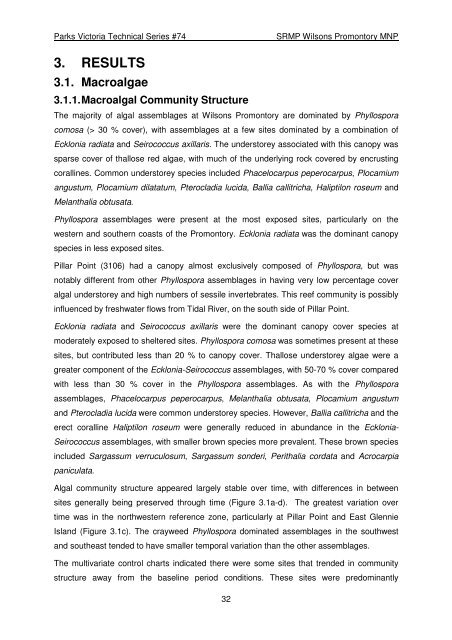the reef biota at Wilsons promontory marine national - Parks Victoria
the reef biota at Wilsons promontory marine national - Parks Victoria
the reef biota at Wilsons promontory marine national - Parks Victoria
- No tags were found...
Create successful ePaper yourself
Turn your PDF publications into a flip-book with our unique Google optimized e-Paper software.
<strong>Parks</strong> <strong>Victoria</strong> Technical Series #74SRMP <strong>Wilsons</strong> Promontory MNP3. RESULTS3.1. Macroalgae3.1.1. Macroalgal Community StructureThe majority of algal assemblages <strong>at</strong> <strong>Wilsons</strong> Promontory are domin<strong>at</strong>ed by Phyllosporacomosa (> 30 % cover), with assemblages <strong>at</strong> a few sites domin<strong>at</strong>ed by a combin<strong>at</strong>ion ofEcklonia radi<strong>at</strong>a and Seirococcus axillaris. The understorey associ<strong>at</strong>ed with this canopy wassparse cover of thallose red algae, with much of <strong>the</strong> underlying rock covered by encrustingcorallines. Common understorey species included Phacelocarpus peperocarpus, Plocamiumangustum, Plocamium dil<strong>at</strong><strong>at</strong>um, Pterocladia lucida, Ballia callitricha, Haliptilon roseum andMelanthalia obtus<strong>at</strong>a.Phyllospora assemblages were present <strong>at</strong> <strong>the</strong> most exposed sites, particularly on <strong>the</strong>western and sou<strong>the</strong>rn coasts of <strong>the</strong> Promontory. Ecklonia radi<strong>at</strong>a was <strong>the</strong> dominant canopyspecies in less exposed sites.Pillar Point (3106) had a canopy almost exclusively composed of Phyllospora, but wasnotably different from o<strong>the</strong>r Phyllospora assemblages in having very low percentage coveralgal understorey and high numbers of sessile invertebr<strong>at</strong>es. This <strong>reef</strong> community is possiblyinfluenced by freshw<strong>at</strong>er flows from Tidal River, on <strong>the</strong> south side of Pillar Point.Ecklonia radi<strong>at</strong>a and Seirococcus axillaris were <strong>the</strong> dominant canopy cover species <strong>at</strong>moder<strong>at</strong>ely exposed to sheltered sites. Phyllospora comosa was sometimes present <strong>at</strong> <strong>the</strong>sesites, but contributed less than 20 % to canopy cover. Thallose understorey algae were agre<strong>at</strong>er component of <strong>the</strong> Ecklonia-Seirococcus assemblages, with 50-70 % cover comparedwith less than 30 % cover in <strong>the</strong> Phyllospora assemblages. As with <strong>the</strong> Phyllosporaassemblages, Phacelocarpus peperocarpus, Melanthalia obtus<strong>at</strong>a, Plocamium angustumand Pterocladia lucida were common understorey species. However, Ballia callitricha and <strong>the</strong>erect coralline Haliptilon roseum were generally reduced in abundance in <strong>the</strong> Ecklonia-Seirococcus assemblages, with smaller brown species more prevalent. These brown speciesincluded Sargassum verruculosum, Sargassum sonderi, Perithalia cord<strong>at</strong>a and Acrocarpiapanicul<strong>at</strong>a.Algal community structure appeared largely stable over time, with differences in betweensites generally being preserved through time (Figure 3.1a-d). The gre<strong>at</strong>est vari<strong>at</strong>ion overtime was in <strong>the</strong> northwestern reference zone, particularly <strong>at</strong> Pillar Point and East GlennieIsland (Figure 3.1c). The crayweed Phyllospora domin<strong>at</strong>ed assemblages in <strong>the</strong> southwestand sou<strong>the</strong>ast tended to have smaller temporal vari<strong>at</strong>ion than <strong>the</strong> o<strong>the</strong>r assemblages.The multivari<strong>at</strong>e control charts indic<strong>at</strong>ed <strong>the</strong>re were some sites th<strong>at</strong> trended in communitystructure away from <strong>the</strong> baseline period conditions. These sites were predominantly32

















